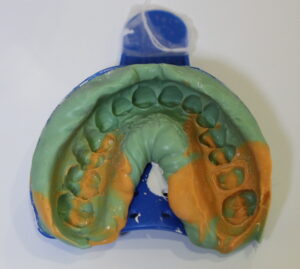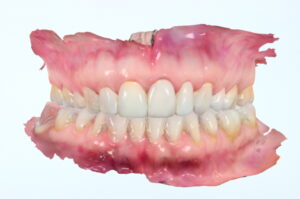[two_third last=”no” spacing=”yes” center_content=”no” hide_on_mobile=”no” background_color=”” background_image=”” background_repeat=”no-repeat” background_position=”left top” border_position=”all” border_size=”0px” border_color=”” border_style=”” padding=”” margin_top=”” margin_bottom=”” animation_type=”” animation_direction=”” animation_speed=”0.1″ class=”” id=””]
Today, we take a look at traditional vs digital impressions. Dental impressions are an most important aspect for all restorative treatments. Whether the restorative process is done in-house or at laboratories, accurate impressions are absolutely essential. In fact, achieving perfect impressions is quite difficult; doctors and dental professionals are presented with many challenges, especially with regard to the materials and technique used for the traditional impression. Even though impression material, mixing, application and setting time have an impact on the impression, the technique remains the most important aspect. Additionally, other challenges include correctly tracing the margin, being able to maintain the comfortable of the patient and obtaining accurate occlusion records.
Over the past 50 years, new materials for traditional impressions have been introduced. Currently, new polyether vinyl silicone (PVS) is mostly used; it has extremely good tear strength, great dimensional stability and neutral taste. Even with the use of this new material, the accuracy of impressions are still not guaranteed.
That’s where digital technology becomes part of the discussion. The development of digital impression systems provides a more precise alternative. With the increased accuracy and efficiency, digital impressions lead to more predictability in creation of restorations. Moreover, the technique for digital impressions has a more gradual learning curve compared to the conventional one.
Additionally, according to several studies, that compared both methods; “there were significant differences between total working time and processing steps. Digital impressions resulted in a more time-efficient and more accurate technique. Patients stated that digital impressions were overall more comfortable”.
With all of that said, most dentists will agree that the digital impressions are better and more efficient in most cases. There are a few exceptions though;
- Deep Subgingival Margins
- Multiple implants
- Super thin preparation
The technology of digital systems has been developed to the point where digital impressions provide a more convenient method with an overall reduced margin of error. On the other hand, there will always be cases that traditional impressions might be the better option. Furthermore, it might be difficult for doctors that have been in the practice for 20+ years to suddenly change. Either way, it seems like we are on track for digital impressions being more and more common in the future, though conventional impressions will likely still have a place.
[/two_third][one_third last=”yes” spacing=”yes” center_content=”no” hide_on_mobile=”no” background_color=”” background_image=”” background_repeat=”no-repeat” background_position=”left top” border_position=”all” border_size=”0px” border_color=”” border_style=”” padding=”” margin_top=”” margin_bottom=”” animation_type=”” animation_direction=”” animation_speed=”0.1″ class=”” id=””]


[/one_third]

